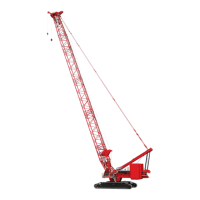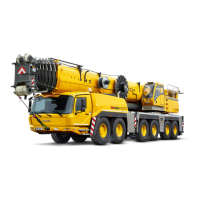Manitowoc Published 09-09-16, Control # 229-09 8-1
MLC650 SERVICE/MAINTENANCE MANUAL UNDERCARRIAGE
SECTION 8
UNDERCARRIAGE
GENERAL
This section provides operational information and electrical
and hydraulic schematics for the following systems:
• Travel System
• Carbody Jack Cylinders
• Crawler/Carbody Pin Pullers
Additional component information for these systems can be
found in the following sections of the Service Manual:
• Section 2: Hydraulics
• Section 3: Electrical
This section also provides repair, maintenance, and
adjustment procedures for the crawler and turntable.
HYDRAULIC TRAVEL SYSTEM
Travel System Overview
The travel system consists of two closed-looped systems,
each consisting of an engine-driven hydraulic pump and two
hydraulic motors.
The travel pumps are electronically controlled, bi-directional,
variable-displacement type of pumps that provide hydraulic
flow to the travel motors.
The travel motors are electronically controlled, bi-directional
variable-displacement type of motors that provide power to
planetary drives.
The speed and direction of the travel motors are dependent
on the output flow volume of the travel pump and the position
of the travel motor servo. The pumps and motors are
electronically controlled by the position of the corresponding
travel control handle (J2 joystick) and the travel speed switch
located on the right console.
The left travel control handle controls pump 3 and the left
travel motors. The right travel control handle controls pump 4
and the right travel motors.
Each travel motor is equipped with a park brake that must be
hydraulically released before travel can occur.
Travel Brake Operation
See Figure 8-1 and Figure 8-3 for the following information.
The travel brakes are a spring-applied, hydraulically
released brake system located between each travel motor
and its corresponding planetary drive. If the brake hydraulic
pressure or electrical control is lost, the brake is applied by
spring force.
The travel brake release system uses charge pressure from
the swing pump, supplied to the travel brake cylinders via the
travel brake release solenoid valve. The brake release
pressure must be at least 16 bar (232 psi) to fully release the
brakes. If the pressure is less than 16 bar (232 psi), the
brakes could remain partially applied, which could damage
the brake system.
Travel Park Brake Disengage
The J2 joystick sends a 24 VDC output to the travel park
switch. The travel park switch is closed in the UN-PARK
position, causing the switch to send a 24 VDC signal back to
the J2 joystick. When 24 VDC is detected, the J2 joystick
activates the travel control handles, but does not allow the
travel park brake to disengage until a travel control handle is
moved.
When a travel control handle is moved, either forward or
rearward, the J2 joystick sends the disengage park brake
command to the IOLC30 control module via the controller
area network bus (CAN Bus). The IOLC30 control module
then sends a 24 V
DC
output to the travel brake release
solenoid valve, energizing the solenoid. The solenoid valve
shifts position, routing hydraulic fluid to the travel brake
pistons, releasing the brakes.
Travel Park Brake Engage
When the travel park switch is moved to the ON-PARK
position, the travel park switch is open, sending a 0 V
DC
signal back to the J2 joystick. When 0 V
DC
is detected, the
J2 joystick deactivates the travel control handles and sends
the engage park brake command to the IOLC30 control
module via the CAN Bus.
The IOLC30 control module then sends a 0V
DC
output
voltage to the travel brake release solenoid valve, de-
energizing the solenoid. This causes the solenoid valve to
return to the default position, allowing the hydraulic fluid in
the brake cylinders to flow through the travel brake release
solenoid valve, then back to the tank. The reduced hydraulic
pressure allows spring force to apply the travel brakes.

